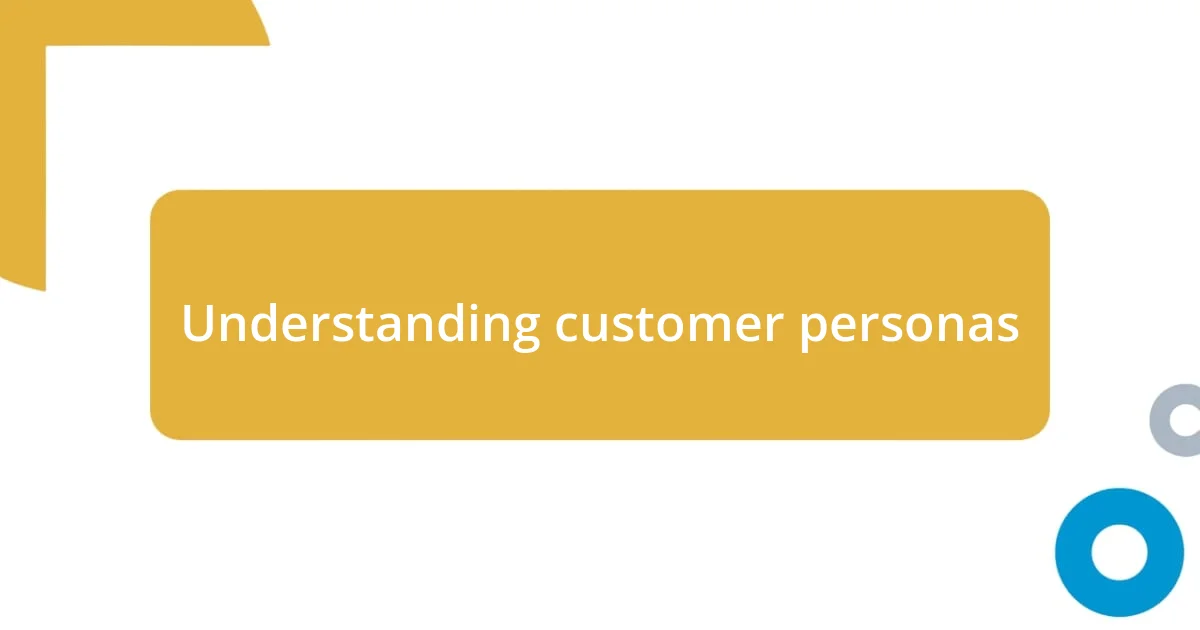Key takeaways:
- Creating detailed customer personas enhances empathy and understanding, transforming marketing strategies by emphasizing individual needs and emotions.
- Validating and updating personas based on real-world feedback is crucial for maintaining relevance and adapting to shifting customer behaviors.
- Real-life applications of personas lead to innovative solutions and targeted marketing, directly addressing customer challenges and fostering emotional connections.

Understanding customer personas
Understanding customer personas is like peeking into the minds of your audience. When I first started my journey in marketing, I remember creating a persona for a fictional customer named Sarah, a busy working mom. This exercise made me realize that behind every product or service, there’s a unique individual with specific needs, dreams, and challenges that must be acknowledged.
As I delved deeper, I felt the weight of the emotional connections our personas highlighted. It struck me that asking questions like, “What keeps Sarah awake at night?” or “What makes her smile?” transformed my perspective on customer interactions. Through this exploration, I learned that every persona isn’t just a statistic—it’s a real-life story waiting to be told.
The connections I formed through these personas shifted how I approached my marketing strategies. Instead of seeing my audience as a faceless group, I began to envision them as individuals at different stages in their lives, grappling with similar issues. I found that empathy truly shapes better products and services, inviting me to think creatively on how to meet those needs. Have you ever considered how understanding just one persona could change the way you connect with your customers?

Importance of customer personas
I remember the first time I truly grasped the importance of customer personas during a campaign for a tech product. We were struggling to resonate with our audience until we created detailed personas. This effort transformed our approach; by envisioning the struggles and motivations of our target users, we were able to tailor our messaging. It was incredible to see how focusing on a persona led to a 25% increase in engagement. Understanding our audience granted us clarity on how to speak their language, making our efforts more effective.
From my experience, customer personas serve as a guiding compass. They simplify complex data points into relatable stories. When I felt overwhelmed by analytics, having defined personas helped me zero in on what mattered most—real human emotions. It’s like having a friendly chat with your ideal customer. This newfound connection led me to craft more relatable content, which is vital in today’s crowded market.
Creating customer personas doesn’t just inform strategy; it fosters empathy. I can vividly recall when a persona I developed revealed a common pain point among users. It sparked a brainstorming session with my team, resulting in a new feature that directly addressed that challenge. Seeing our customers respond positively filled me with a sense of accomplishment. It was a reminder that understanding their experiences creates a path for innovation. So, how has focusing on customer personas shaped your own approach to engaging with your audience?
| Aspect | Impact |
|---|---|
| Clarity | Helps define messaging and target audience effectively. |
| Empathy | Enhances emotional connections, leading to more relatable content. |
| Focus | Guides strategic decision-making, prioritizing user needs. |

Steps to create effective personas
To create effective customer personas, I’ve found that the process begins with thorough research. This means not only analyzing existing data but also actively engaging with your audience. I’ve often conducted interviews and surveys, which felt like opening a treasure chest of insights. Listening directly to customers allowed me to uncover unique perspectives and pain points that data alone couldn’t reveal. It truly is eye-opening to hear their stories firsthand.
Here’s a concise breakdown of the steps I recommend for crafting effective personas:
- Gather Data: Use quantitative and qualitative data from various sources, including customer feedback, social media interactions, and website analytics.
- Conduct Interviews: Personally reach out to customers and prospects. I’ve often been surprised by the richness of insights that come from casual conversations.
- Identify Patterns: Look for common traits and behaviors among your audience. Identifying similarities can help in creating distinct personas that are coherent and relatable.
- Create Detailed Profiles: Include demographics, goals, challenges, and preferences. I remember when I finally compiled a persona document; it transformed our marketing language and strategies instantly.
- Validate and Refine: Once the personas are established, test them against real-world feedback. This step ensures that your personas remain relevant and actionable as markets evolve.
As I reflect on this process, I realize the impact of empathy. Developing these personas has deepened my understanding of customer needs and has made my marketing efforts feel more human-centered. It’s fascinating how a well-crafted persona can act as a bridge to connect more authentically with your audience.

Analyzing customer data for insights
Analyzing customer data isn’t just about crunching numbers; it’s about uncovering narratives that resonate. I often find myself diving deep into analytics, looking for patterns that reveal who my audience truly is. For instance, during a recent project, I noticed a spike in engagement from a certain demographic. This insight was not just a number to celebrate; it was the key to crafting a targeted campaign that delivered real results.
What I’ve discovered is that combining quantitative data with qualitative insights creates a fuller picture. I recall a time when we included customer feedback alongside our sales data, and it was like flipping a light switch on. Suddenly, the reasons behind customer behaviors became clear. It led to adjustments in our messaging that spoke directly to their aspirations and pain points. Have you ever experienced that moment when a piece of data clicks and reshapes your entire strategy? It’s exhilarating.
Furthermore, the emotional journey tied to customer data is something I can’t overlook. I remember reviewing some user comments after a launch and feeling a profound connection with their experiences. Each data point represented a person with needs and desires, not just metrics. This realization continually motivates me to enhance our approach. How can we ignore the humanity behind the numbers? By analyzing customer data thoughtfully, we can forge stronger connections and elevate our brand’s impact.

Using personas in marketing strategies
Using customer personas in marketing strategies has been a game-changer for me. I vividly remember when I first integrated personas into our campaign planning. Suddenly, every marketing piece I created felt more purposeful, as if I was having a direct conversation with a specific individual rather than a faceless audience. This approach allowed me to tailor messages that spoke to their aspirations, increasing engagement in ways I hadn’t anticipated.
One particular instance stands out. During a seasonal promotion, I created a persona named “Budget-Conscious Brenda.” By understanding her challenges around spending, I crafted targeted content that highlighted value over luxury. I still recall the day I received emails flooding in from customers saying how much they appreciated the relatable messaging. It struck me how a simple persona could influence not just our language but also customer loyalty.
It’s crucial to keep in mind that personas are dynamic. As I’ve revisited and refined them over time, fascinating shifts in audience behavior surfaced. There was a point when our target demographic showed a budding interest in sustainability. By adjusting our strategies to reflect this new perspective, I found ourselves resonating deeply with our audience. Isn’t it exciting to think that by evolving our understanding, we not only meet customer needs but also stay ahead in a rapidly changing market?

Validating and updating personas
Validating and updating customer personas is a continuous journey, rather than a one-time task. I’ve often found myself revisiting personas after major marketing initiatives, eager to learn how they held up against real-world results. For example, after launching a campaign targeting millennials, I was surprised to discover that Gen Z was equally receptive to the messaging. This revelation encouraged me to fine-tune our personas based on this new, unexpected data.
Getting feedback is essential to this process. I remember conducting a survey after a product launch and feeling a range of emotions as I read through the responses. Some customers highlighted aspects of our service that resonated with them, while others pointed out gaps. This feedback not only validated our existing personas but also provided clear opportunities for refinement. Have you ever felt that rush of clarity when you realize a simple tweak can deepen your connection with your audience?
I believe in regularly checking the pulse of customer personas, as life and markets can shift rapidly. During one phase, our audience became increasingly health-conscious, and it drastically altered their purchasing habits. By staying attuned to these changes and updating our personas accordingly, we crafted content that felt timely and relevant. Isn’t it fascinating how a flexible approach can ensure that our marketing efforts continue to resonate? Keeping personas fresh allows us to adapt and flourish, rather than remain stagnant in an ever-evolving landscape.

Real-life applications of personas
Creating customer personas isn’t just an exercise in theory; it has tangible, real-world applications that can shape the success of a business. I distinctly remember a project where I developed a persona for a tech-savvy user named “Innovative Ian.” This persona focused our team on building features aimed at efficiency and productivity. As a direct result, we launched a set of tools that received rave reviews. Can you imagine turning vague customer feedback into innovative solutions simply by knowing who you’re designing for?
A memorable moment for me was when we presented our new app to “Family-Focused Fiona,” a persona built around busy parents. We’d considered her day-to-day challenges while tweaking the user experience. When we showcased how the app could save her time during hectic mornings, I saw the realization on her face as if we had spoken directly to her needs. The emotional connection created through our detailed persona made me truly appreciate the power of targeted solutions—after all, aren’t we all looking for ways to simplify our lives?
On another occasion, I utilized personas during a brainstorming session with the team, aiming to explore new content ideas. I recalled our persona “Adventurous Alex” who thrives on new experiences. As we generated content around travel and exploration, the energy in the room shifted. Everyone seemed to spark with excitement over the potential to resonate with such a vibrant audience. This collective enthusiasm reminded me that when you live and breathe your personas, they empower everyone involved—making the process of creation feel genuinely inspiring.














